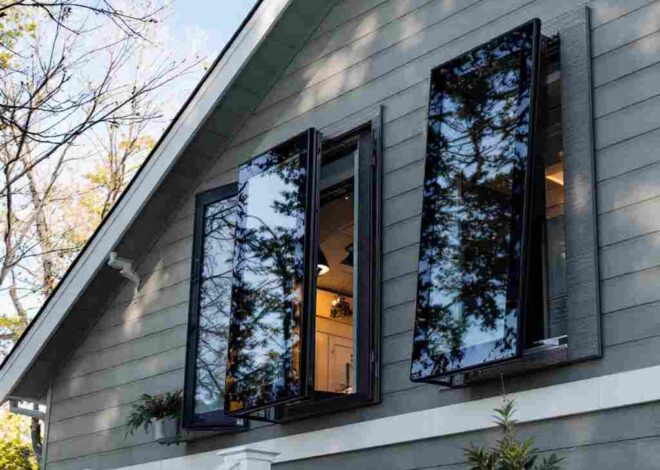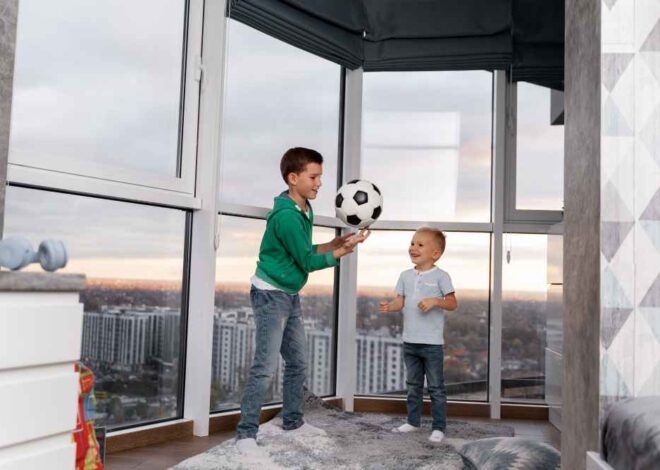
Maximize Curb Appeal: How to Select the Best Window Style for Your Home’s Architecture
When it comes to making a lasting first impression, your home’s exterior is like its face—inviting and charming or dull and forgettable. Among the key features that can dramatically elevate your curb appeal are the windows! These architectural gems do more than just let in light; they frame views, define style, and contribute significantly to your home’s overall character. But with so many window styles available—from classic double-hung designs to sleek modern casements—it can be overwhelming to choose the right ones that harmonize beautifully with your home’s architecture. Fear not!
Introduction to Curb Appeal and the Role of Windows
Curb appeal is more than just a buzzword; it’s the first impression your home makes on visitors and passersby. Among the many elements that contribute to this appeal, windows play a pivotal role. They not only frame views but also enhance architectural beauty and functionality. Choosing the right window style can transform an ordinary façade into an inviting masterpiece.
Whether you’re looking to sell your home or simply want to elevate its aesthetic, understanding how to select window styles that complement your home’s architecture is essential. The right windows can boost energy efficiency while adding character and charm. Ready to dive in? Let’s explore how you can maximize curb appeal with the perfect window choices for your unique space.
Understanding Your Home’s Architecture
Every home tells a story through its architecture. Understanding this narrative is crucial when selecting window styles.
Start by identifying the architectural elements of your house. Is it modern, traditional, or something in between? Each style has distinct features that influence design choices.
Look at the roofline, materials, and overall shape. These aspects will guide you toward compatible window options that enhance harmony rather than create discord.
Consider regional influences too. A beach house might favor large picture windows for ocean views, while a rustic cabin could benefit from smaller casement windows to complement wooden accents.
Don’t forget about historical context! If your home is older or inspired by classic designs, sticking with period-appropriate window styles will maintain its authentic charm.
Different Window Styles: Pros and Cons
When choosing window styles, it’s essential to weigh their pros and cons carefully.
Single and double-hung windows offer a classic look but can be challenging to clean, especially on upper floors. Their traditional design fits many home styles.
Casement windows open outward for excellent ventilation. They provide unobstructed views but require space outside for them to swing open.
Picture windows are perfect for showcasing beautiful landscapes. However, they don’t offer ventilation or functionality beyond aesthetics.
Bay and bow windows create stunning focal points that extend living spaces. Their complexity can increase installation costs significantly.
Sliding windows allow easy operation with minimal maintenance needs, though they might not suit all architectural designs.
Awning windows are great for letting in fresh air during rainstorms since they open at the top. Yet, their unconventional appearance may not appeal to everyone’s taste.
-
Single and Double-Hung Windows
Single and double-hung windows are popular choices for many homeowners. Their classic design fits seamlessly into various architectural styles.
Single-hung windows feature a fixed upper sash and a movable lower sash. This means you can easily open the bottom half for ventilation while keeping the top sealed. They’re often more affordable, making them an attractive option for budget-conscious renovations.
On the other hand, double-hung windows allow both sashes to move up and down. This versatility provides enhanced airflow options. You can also clean both sides of the glass from inside your home, which is especially convenient.
Both styles come in various materials and finishes, allowing you to customize their look without sacrificing functionality. Whether you’re aiming for traditional charm or modern elegance, single or double-hung windows can elevate your home’s aesthetic appeal effortlessly.
-
Casement Windows
Casement windows are a stylish choice that can enhance any home. They are hinged at the side and open outward, offering a wide view of the outdoors. This design allows for maximum airflow, making them ideal for catching summer breezes.
One of their standout features is ease of use. You can operate them with a simple crank, which adds convenience to hard-to-reach areas like above sinks or counters. The smooth operation also makes them child-friendly.
These windows come in various materials, including wood, vinyl, and fiberglass. Each material offers different aesthetics and maintenance levels to suit your preferences.
Furthermore, they provide excellent energy efficiency when properly sealed. Their tight closure helps prevent drafts while ensuring comfort year-round.
With their modern appeal and practical benefits, casement windows could be the perfect addition to your home’s architectural style.
-
Picture Windows
Picture windows are a stunning choice for homeowners who want to frame beautiful views. These large, fixed windows allow natural light to flood your space while providing unobstructed sightlines of the outdoors.
They come in various shapes and sizes, making them versatile for different architectural styles. Picture windows work particularly well in living rooms or dining areas where scenic vistas can be enjoyed. This style offers a clean look that enhances modern aesthetics and classic designs alike.
However, it’s important to note that picture windows do not open. While they offer exceptional visibility and light access, they lack ventilation options. Pairing them with operable window styles can create both beauty and functionality in your home design.
Selecting the right frame material also enhances their appeal—wood provides warmth, while vinyl is low-maintenance and durable.
-
Bay and Bow Windows
Bay and bow windows are stunning features that extend beyond the walls of your home. They create a cozy nook while inviting ample natural light.
A bay window typically consists of three panes, with the center pane larger than the side ones. This design offers depth and visual interest to any room. In contrast, bow windows feature multiple panels that curve gently outward, providing a more rounded appearance.
These windows not only enhance curb appeal but also expand interior space. You can transform them into reading corners or plant displays—perfect for adding character to your living area.
However, they require careful consideration regarding installation and maintenance. Ensure proper sealing to prevent leaks and drafts over time. With thoughtful care, bay and bow windows can become timeless elements in your home’s architecture.
-
Sliding Windows
Sliding windows are a popular choice for homeowners looking to blend functionality with modern aesthetics. They consist of two or more sashes that slide horizontally, making them easy to operate and ideal for spaces where traditional swinging windows might be impractical.
One major advantage of sliding windows is their space-saving design. Since they don’t require any clearance to open outward, you can place furniture right up against the window without worrying about obstruction. This feature makes them perfect for smaller rooms or tight patios.
Additionally, sliding windows often provide expansive views and ample natural light. With fewer frames in sight, the glass area maximizes your view of the outdoors while enhancing indoor brightness.
On the downside, cleaning can pose a challenge because both sides of the outer pane may be difficult to reach from inside. However, many modern designs come equipped with removable sashes that simplify maintenance tasks considerably.
-
Awning Windows
Awning windows are a unique choice for homeowners looking to blend functionality with style. These hinged windows open outward from the bottom, creating an awning effect that allows fresh air in while keeping rain out.
Their design is particularly advantageous for areas prone to unpredictable weather. You can enjoy ventilation without worrying about water damage inside your home. This feature makes them ideal for kitchens and bathrooms.
In terms of aesthetics, awning windows offer a modern touch. They can be combined with other window styles or used as standalone features, enhancing the architectural appeal of your home.
Energy efficiency is another strong point; they provide a tight seal when closed, minimizing drafts and heat loss. With various materials and finishes available, awning windows can complement both traditional and contemporary designs effortlessly.
Factors to Consider When Choosing a Window Style for Your Home
When selecting a window style, functionality is key. Think about how you use each room. Do you need ventilation or natural light? Different styles offer varying degrees of both.
Aesthetics also play a significant role in your choice. The right windows should complement the overall design of your home. Consider colors and materials that enhance your exterior while reflecting personal taste.
Energy efficiency cannot be overlooked either. Windows contribute to insulation and can keep energy costs down. Look for options with good ratings to ensure you’re making an eco-friendly choice.
Lastly, maintenance matters too. Some window styles require more upkeep than others. Choose something that fits not only your lifestyle but also the time you’re willing to invest in care and cleaning.
-
Functionality
Functionality is a crucial factor when selecting window styles for your home. It goes beyond aesthetics, directly impacting the comfort and usability of your living space.
Consider how you plan to use each room. For instance, a casement window allows for maximum airflow by swinging open outward. This can enhance ventilation in kitchens or bathrooms where moisture control is essential.
On the other hand, sliding windows are perfect for tight spaces. They provide easy access without taking up interior space when opened.
Think about how much maintenance you’re willing to commit to as well. Some styles require more upkeep than others, especially if they’re exposed to harsh weather conditions.
Ultimately, choosing functional windows ensures that they serve their purpose effectively while adding beauty to your home’s facade.
-
Aesthetics
Aesthetics play a crucial role in selecting window styles that enhance your home’s exterior. The right windows not only frame beautiful views but also complement the architectural design.
Consider how different shapes and sizes influence your home’s overall look. For instance, large picture windows can create a modern feel, while smaller casement windows might evoke charm and tradition.
Colors and materials also matter. A sleek aluminum finish offers a contemporary touch, whereas wooden frames bring warmth to classic designs.
Window grids or muntins add character too; they can make an otherwise plain design more visually interesting without overpowering other features of the facade.
Ultimately, choosing the right aesthetic aligns with personal taste while respecting your home’s unique style. Each decision adds another layer of beauty to your property and contributes significantly to its curb appeal.
-
Energy Efficiency
Energy efficiency plays a crucial role in selecting window styles. Windows can be responsible for significant heat loss or gain in your home. Choosing the right type helps maintain a comfortable indoor temperature year-round.
Look for double or triple-glazed options, as these provide better insulation than single-pane windows. Low-E coatings can also reflect heat back into your home during winter while keeping it cool in summer.
Consider the frame material too. Vinyl and fiberglass tend to offer superior thermal performance compared to aluminum frames, which conduct heat more readily.
Don’t forget about proper installation; even the best windows won’t perform well if poorly installed. Sealing gaps and ensuring airtightness are essential steps that maximize energy savings.
By investing time in understanding energy-efficient window styles, you not only enhance comfort but also contribute positively to your utility bills over time.
You may also read (top benefits installing skylight windows)
Matching Window Styles to Different Architectural Styles
When selecting window styles, it’s crucial to consider your home’s architectural style. Each design has its unique characteristics that can enhance or detract from the overall aesthetic.
Traditional homes often benefit from classic double-hung windows. Their timeless appeal complements ornate details and symmetrical designs.
Contemporary homes lean towards sleek casement or picture windows. These options provide clean lines and maximize natural light, fitting perfectly with minimalist architecture.
Colonial homes typically feature multi-pane designs in double-hung or sliding windows. This choice maintains historical integrity while offering practicality and charm.
Craftsman-style houses shine with wood-framed awning or bay windows. These styles reflect the artistry of the era and invite a warm, inviting feel into the living space.
Choosing window styles that resonate with your architecture will create a cohesive look that speaks to both beauty and functionality.
-
Traditional Homes
Traditional homes often feature classic architectural elements that evoke a sense of history and charm. These styles may include Colonial, Victorian, or Georgian designs. Each has unique characteristics but shares a commitment to symmetry and refined details.
When selecting window styles for traditional homes, consider options like double-hung windows with decorative trim. They enhance the elegant lines typical of this architecture while providing functionality.
Another excellent choice is casement windows that can be adorned with divided lights for an authentic look. This style complements the craftsmanship synonymous with traditional designs.
Additionally, bay or bow windows can add depth and visual interest to your home’s facade. They create inviting nooks inside while amplifying curb appeal outside.
Choosing the right window style elevates both aesthetics and value in these timeless structures.
-
Contemporary Homes
Contemporary homes often embrace clean lines and open spaces. The design philosophy prioritizes minimalism, making window styles a crucial element in achieving this aesthetic.
For these homes, large picture windows can create seamless connections to the outdoors. They invite natural light while offering stunning views.
Sliding windows also fit well with contemporary architecture. Their straightforward operation complements the sleek look of modern designs.
Casement windows add a touch of elegance with their outward swing. This style not only enhances ventilation but also aligns beautifully with contemporary forms.
Consider energy-efficient options when selecting window styles for your home. Modern materials and technology ensure that aesthetics don’t compromise performance.
The right choice can elevate your home’s architectural identity while maximizing curb appeal in an impressive way.
-
Colonial Homes
Colonial homes are known for their classic elegance and symmetry. Their design often features multi-paned windows that offer a timeless appeal. When selecting window styles, consider double-hung options to maintain authenticity.
These windows allow for both functionality and ventilation, making them practical as well.
Shuttered designs can further enhance the historical aesthetic while providing added charm to your facade.
Incorporating casement windows in certain areas can bring a touch of modern convenience without straying from tradition.
The key is to balance period accuracy with contemporary needs. Choose window frames in colors that complement traditional Colonial palettes like white or muted shades.
This thoughtful approach ensures your home retains its legacy while benefiting from today’s technology and energy efficiency standards.
-
Craftsman Homes
Craftsman homes are known for their distinctive architectural style, characterized by handcrafted details and natural materials. The warm and inviting aesthetics make them stand out in any neighborhood.
When selecting window styles for a Craftsman home, consider options that complement its unique design. Double-hung windows with divided lites provide a classic look that enhances the home’s charm.
Casement windows also work well, offering an open feel while maintaining energy efficiency. Their side hinges allow for wide openings, perfect for breezy days.
Incorporating wooden frames can further enhance the craftsmanship appeal. Rich wood tones blend seamlessly with the earthy colors of Craftsman architecture.
Don’t overlook decorative elements like window boxes or stained glass accents to add a personal touch. These features not only highlight your windows but also enrich your home’s character beautifully.
Tips for Enhancing Curb Appeal with Window Design Choices
Choosing the right window styles can dramatically enhance your home’s curb appeal. Start by considering window trim that complements your home’s architecture. A fresh coat of paint in a bold color can make windows pop.
Incorporate decorative elements like shutters or flower boxes for added charm. These features not only beautify but also create visual interest.
Consider the landscaping around your windows as well. Keep plants tidy and choose vibrant blooms to frame your view, drawing attention to those lovely panes.
Utilizing window treatments inside adds elegance too. Sheer curtains allow natural light while maintaining privacy, creating an inviting atmosphere visible from outside.
Lastly, ensure that all hardware is functional and stylish, from handles to locks. Small details count when it comes to enhancing overall aesthetics—every element should work together harmoniously for maximum impact on curb appeal.
Conclusion: Finding the Perfect Window Style for home
Selecting the ideal window style for your home involves careful consideration of various factors. Your windows are more than just openings; they play a key role in defining your home’s character and charm. By understanding the unique architectural features of your residence, you can make informed choices that complement its design while also enhancing functionality.
It’s essential to weigh the pros and cons of different window styles. Whether you prefer classic single-hung windows or modern casement options, each style offers distinct benefits tailored to diverse aesthetics. Functionality, energy efficiency, and visual appeal should guide your decision-making process.
Moreover, aligning window selections with specific architectural styles ensures harmony throughout your property. Traditional homes often benefit from timeless designs like double-hung or bay windows, while contemporary houses might shine with sleek picture windows or sliding varieties.
Enhancing curb appeal through thoughtful window design not only beautifies your space but can also increase its market value. A well-chosen window style adds layers of personality to a home’s exterior, inviting admiration from passersby and potential buyers alike.
Ultimately, finding the perfect window style is about balancing beauty with practicality—creating an inviting atmosphere that reflects both personal taste and structural integrity. As you embark on this journey towards maximizing curb appeal, keep these guiding principles in mind for a successful transformation.
You may also read (the cost of window replacement for your home)


